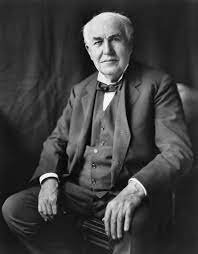Who invented the light bulb
Categories: science education

Who invented the light bulb?
However Thomas Edison is normally credited as the one who concocted the light, there owned American creator wasn't the one in particular who added to the improvement of this progressive innovation.
The tale of the light starts some time before Edison licensed the primary monetarily fruitful bulb in 1879. In 1800, Italian designer Alessandro Volta fostered the primary useful technique for producing electricity(opens in new tab), the voltaic heap. Made of exchanging circles of zinc and copper(opens in new tab) —scattered with layers of cardboard absorbed salt water — the heap directed power when a copper wire was associated at one or the flip side. Volta's sparkling copper wire is formally viewed as a forerunner to the battery, but on the other hand is one of the earliest indications of glowing lighting.
Davy's 1802development was known as an electric circular segment light, named for thebrilliant bend of light produced between its two carbon poles, as per "TheExistence of Sir Humphrey Davy(opens in new tab)" (HardPressDistributing, 2016)
While Davy'sbend light was surely an enhancement for Volta's independent heaps, it actuallywas definitely not an extremely reasonable wellspring of lighting. This simplelight worn out rapidly and was excessively splendid for use in a home or workarea. Anyway in a 2012 talk for the Procedures of the American PhilosophicalSociety(opens in new tab), John Meurig Thomas composed that Davy's differentexaminations with lighting prompted both the diggers' wellbeing light, andfurthermore road lighting in Paris "and numerous other European urbancommunities." The standards behind Davy's curve light were utilizedall through the 1800s in the improvement of numerous other electric lights andbulbs.
In 1840,English researcher Warren de la Mourn fostered an effectively planned lightinvolving a wound platinum fiber instead of copper, however the significantexpense of platinum held the bulb back from turning into a businessachievement, as per Fascinating Engineering(opens with regards to new tab). In1848, British bloke William Staite worked on the life span of regular curvelights by fostering a precision component that controlled the development ofthe lights' fast to-disintegrate carbon poles, as per the Establishment ofDesigning and Technology(opens in new tab). Be that as it may, the expense ofthe batteries used to drive Staite's lights likewise restricted their pragmaticapplications.
Edisonunderstood that the issue with Swan's plan was the fiber. A flimsy fiber withhigh electrical opposition would make a light reasonable on the grounds that itwould require simply somewhat flow to make it gleam. He exhibited his light,with a platinum fiber in a glass vacuum bulb, in December 1879 in Menlo Park, NewJersey, as per the Franklin Institute(opens in new tab). Swan integrated theimprovement into his lights and established an electrical lighting organizationin Britain.
Edison suedfor patent encroachment, yet Swan's patent was serious areas of strength for a,to some extent in the U.K., as per CIO(opens in new tab). The two designers inthe end combined efforts and framed Edison-Swan Joined together, which becameone of the world's biggest makers of lights, as per the Science Exhibition hallGathering (opens in new tab).
In Nov.1879, Edison documented a patent for an electric light with a carbon fiber, asper the Public Archives.(opens in new tab) The patent recorded a few materialsthat may be utilized for the fiber, including cotton, cloth and wood. Edisonwent through the following year finding the ideal fiber for his new bulb,testing in excess of 6,000 plants to figure out which material would consumethe longest.
A whileafter the 1879 patent was conceded, Edison and his group found that a carbonizedbamboo fiber could consume for over 1,200 hours, as per the Edison Museum(opensin new tab). Bamboo was utilized for the fibers in Edison's bulbs until itstarted to be supplanted by longer-enduring materials during the 1880s to mid1900s.
In 1882,Lewis Howard Latimer, one of Edison's specialists, licensed a more effectiveapproach to assembling carbon fibers, as per Rutgers University(opens in newtab). Also, in 1903, Willis R. Whitney imagined a treatment for these fibersthat permitted them to shine brilliantly without obscuring the internal partsof their glass bulbs, as per the Smithsonian Institution(opens in new tab).
WilliamDavid Coolidge, an American physicist with General Electric, worked on theorganization's strategy for assembling tungsten fibers in 1910. Tungsten, whichhas the most elevated softening mark of any substance component, was known byEdison to be a fantastic material for light fibers, however the apparatusexpected to deliver super-fine tungsten wire was not accessible in the latenineteenth hundred years.